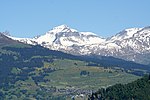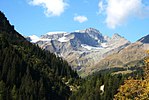Laaxer Stöckli
Glarus–Graubünden borderGraubünden geography stubsMountains of GraubündenMountains of SwitzerlandMountains of the Alps ... and 2 more
Mountains of the canton of GlarusTwo-thousanders of Switzerland

The Laaxer Stöckli (also known as Piz Grisch) is a 2,898 metre-high mountain of the Glarus Alps, located on the border between the cantons of Glarus and Graubünden in Eastern Switzerland. It lies approximately halfway between the Vorab and Piz Segnas. The Laaxer Stöckli belongs to the municipalities of Glarus Süd and Laax. The closest localities are Elm and Flims. The south side is part of the Flims-Laax ski area. A chairlift reaches La Siala at a height of 2,806 metres.
Excerpt from the Wikipedia article Laaxer Stöckli (License: CC BY-SA 3.0, Authors, Images).Laaxer Stöckli
Laaxer Stöckli, Glarus Süd
Geographical coordinates (GPS) Address Nearby Places Show on map
Geographical coordinates (GPS)
| Latitude | Longitude |
|---|---|
| N 46.883055555556 ° | E 9.2041666666667 ° |
Address
Laaxer Stöckli
Laaxer Stöckli
Glarus Süd
Glarus, Switzerland
Open on Google Maps










